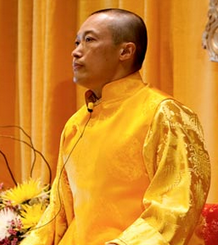Monday
Dharma TeachingsThe Practice of Peaceful Abiding
Dharma Teaching
by Sakyong Mipham Rinpoche
 Preparing to Practice
Preparing to Practice
Taming our mind through shamatha meditation, or “peaceful abiding,” is the most important thing we can do. Through peaceful abiding, we learn to rest fearlessly in our natural state, which is basic goodness. We experience basic goodness when we relax deeply into how things are, without wanting to change them. This is why we meditate. Even though we may think we don’t have time to practice, the stability, clarity and strength we’ll discover through meditation can make our life simpler and less pressured.
The first step is to establish a basic routine. When will you practice, and where? Once you settle on a regular time, stick to it. A successful meditation practice is a consistent practice. Ten to twenty minutes of sitting practice a couple of times daily over a lifetime is good.
Create a proper environment for practice—a place that is comfortable, quiet, and clean. Buy a proper meditation cushion. Prepare the body for meditation with yoga, a martial art, or simply stretching. A supple body helps support peaceful abiding. So does eating properly.
Prepare your mind for practice by assessing how it feels before your session. Be compassionate and honest in this; each day is different. If you’re feeling speedy or drowsy, a slow walk or a cool shower might help your meditation before you start. If you’re just out of the office or an argument, reading about meditation can provide a helpful bridge to the cushion.
The Technique
We approach our meditation seat as if it were a throne in the center of our life. By taking an upright sitting posture, we enable the body to relax and the mind to be awake.
On a cushion or a chair, take a balanced, grounded seat. On a cushion, sit with your legs loosely crossed. In a chair, keep your legs uncrossed and your feet flat on the floor. Imagine a string attached to the top of your head, pulling your spine erect. Let your organs, muscles and bones settle around your uplifted spine, allowing the energy in the center of your body to move freely. Slouching impairs the breathing, which directly affects the mind. Place your hands on your thighs, palms down. The fingers are close to each other and relaxed.
Tuck your chin in gently and relax your jaw. Relax your tongue; rest the tip against your upper teeth. Let the mouth be slightly open. Gaze downwards with the eyelids half shut.
In peaceful abiding, the object of meditation is the act of breathing. By resting the mind on the breath we train in staying present and mindful. So now become aware of the breath. Stay with the feeling of the breathing. Breathe normally. If you space out or lose track of the breath, count the in- and out-cycles of breathing. Once you’re more focused, drop the counting and focus on the air moving in and out, which allows some steadiness in contrast to our usual mental discursiveness. It also helps us relax. As our thoughts slow down and we settle into ourselves, our body and mind become synchronized.
We’ll notice that even as we rest our mind on the breath, thoughts and emotions continue to distract us. We may become swept away and forget that the breath—not our fantasies, emotions and discursive thoughts—is the object of our meditation. When we notice that we’ve been distracted by our thinking, we acknowledge it, either silently or by labeling it “thinking.” In either case, we bring our minds back to the breath. We acknowledge the thought, allow it to dissipate and return to the breath.
Just as in learning to ride, one of the biggest challenges in beginning to meditate is balance. We need to balance our posture, the placement of our breath, and recognizing, acknowledging and releasing thoughts. It takes a while to coordinate these elements. We’re always going to have a certain amount of thinking, and if we come down hard on ourselves about that, our meditation will feel like boot camp.
It’s important to remember that the technique of peaceful abiding involves gentleness as well as precision. Gently coming back to the breath will help us appreciate the basic quality of who we are. And we need precision to remember to apply the technique without judgment or analysis. We simply recognize thoughts as thoughts, and without being distracted by them, return to the breath. The instruction is really pretty simple: When you lose your mind, come back.
After Meditation
At the end of your session enjoy the space you’ve created by peacefully abiding, and arise. In daily life, you may notice that it’s easier to be present for what’s happening, to communicate clearly with others and to focus your mind despite distracting thoughts and emotions.
As you continue to meditate, you might encounter obstacles and questions. A meditation instructor can give you tips on aspects of practice that you find difficult. Many meditation centers offer free instruction as well as communities of experienced practitioners who can provide friendship and support.
(c) 2003 by Mipham J. Mukpo

















Jun 8, 2015
Reply
Thank you Rinpoche! Reading and contemplating the instructions again and putting them into practice seems very help helpful!